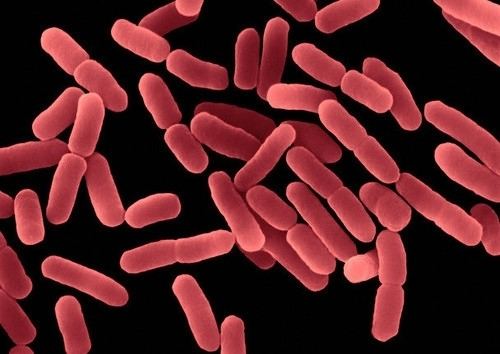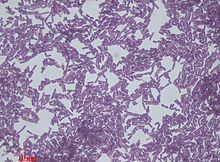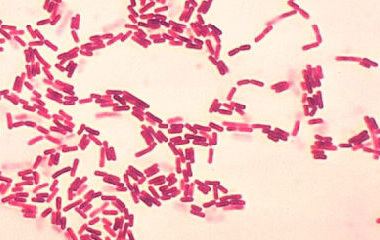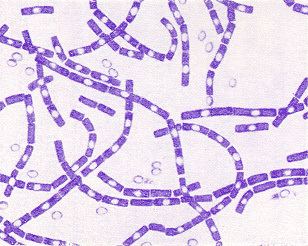Higher classification Bacillaceae | Scientific name Bacillus Rank Genus | |
 | ||
Lower classifications Hay bacillus, Bacillus thuringiensis, Bacillus licheniformis, Bacillus megaterium, Bacillus coagulans Similar Bacillus coagulans, Bacillus licheniformis, Bacillus megaterium | ||
Bacillus bacteria 3d
Bacillus is a genus of gram-positive, rod-shaped bacteria and a member of the phylum Firmicutes. Bacillus species can be obligate aerobes (oxygen reliant), or facultative anaerobes (having the ability to be aerobic or anaerobic). They will test positive for the enzyme catalase when there has been oxygen used or present. Ubiquitous in nature, Bacillus includes both free-living (nonparasitic) and parasitic pathogenic species. Under stressful environmental conditions, the bacteria can produce oval endospores that are not true 'spores', but to which the bacteria can reduce themselves and remain in a dormant state for very long periods. These characteristics originally defined the genus, but not all such species are closely related, and many have been moved to other genera of the Firmicutes.
Contents
- Bacillus bacteria 3d
- Bacillus f bacteria is key to eternal life found russian scientist claims
- Industrial significance
- Use as model organism
- Ecological significance
- Clinical significance
- Cell wall
- Phylogeny
- References

Many species of Bacillus can produce copious amounts of enzymes which are made use of in different industries. Some species can form intracellular inclusions of polyhydroxyalkanoates under certain adverse environmental conditions, as in a lack of elements such as phosphorus, nitrogen, or oxygen combined with an excessive supply of carbon sources.

B. subtilis has proved a valuable model for research. Other species of Bacillus are important pathogens, causing anthrax and food poisoning.

Bacillus f bacteria is key to eternal life found russian scientist claims
Industrial significance

Many Bacillus species are able to secrete large quantities of enzymes. Bacillus amyloliquefaciens is the source of a natural antibiotic protein barnase (a ribonuclease), alpha amylase used in starch hydrolysis, the protease subtilisin used with detergents, and the BamH1 restriction enzyme used in DNA research.

A portion of the Bacillus thuringiensis genome was incorporated into corn (and cotton) crops. The resulting GMOs are therefore resistant to some insect pests.
Use as model organism

Bacillus subtilis is one of the best understood prokaryotes, in terms of molecular and cellular biology. Its superb genetic amenability and relatively large size have provided the powerful tools required to investigate a bacterium from all possible aspects. Recent improvements in fluorescent microscopy techniques have provided novel insight into the dynamic structure of a single cell organism. Research on B. subtilis has been at the forefront of bacterial molecular biology and cytology, and the organism is a model for differentiation, gene/protein regulation, and cell cycle events in bacteria.
Ecological significance
Bacillus species are almost ubiquitous in nature, e.g. in soil, but also occur in extreme environments such as high pH (B. alcalophilus), high temperature (B. thermophilus), or high salt (B. halodurans). B. thuringiensis produces a toxin that can kill insects and thus has been used as insecticide.
Clinical significance
Two Bacillus species are considered medically significant: B. anthracis, which causes anthrax, and B. cereus, which causes food poisoning similar to that caused by Staphylococcus. A third species, B. thuringiensis, is an important insect pathogen, and is sometimes used to control insect pests. The type species is B. subtilis, an important model organism. It is also a notable food spoiler, causing ropiness in bread and related food. Some environmental and commercial strains of B. coagulans may play a role in food spoilage of highly acidic, tomato-based products.
An easy way to isolate Bacillus species is by placing nonsterile soil in a test tube with water, shaking, placing in melted mannitol salt agar, and incubating at room temperature for at least a day. Colonies are usually large, spreading, and irregularly shaped. Under the microscope, the Bacillus cells appear as rods, and a substantial portion of the cells usually contain oval endospores at one end, making it bulge.
Cell wall
The cell wall of Bacillus is a structure on the outside of the cell that forms the second barrier between the bacterium and the environment, and at the same time maintains the rod shape and withstands the pressure generated by the cell's turgor. The cell wall is composed of teichoic and teichuronic acids. B. subtilis is the first bacterium for which the role of an actin-like cytoskeleton in cell shape determination and peptidoglycan synthesis was identified, and for which the entire set of peptidoglycan-synthesizing enzymes was localised. The role of the cytoskeleton in shape generation and maintenance is important
Phylogeny
The genus Bacillus was named in 1835 by Christian Gottfried Ehrenberg, to contain rod-shaped (bacillus) bacteria. He had seven years earlier named the genus Bacterium. Bacillus was later amended by Ferdinand Cohn to further describe them as spore-forming, Gram-positive, aerobic or facultatively anaerobic bacteria. Like other genera associated with the early history of microbiology, such as Pseudomonas and Vibrio, the 266 species of Bacillus are ubiquitous. The genus has a very large ribosomal 16S diversity and is environmentally diverse.
Several studies have tried to reconstruct the phylogeny of the genus. The Bacillus-specific study with the most diversity covered is by Xu and Cote using 16S and the ITS regions, where they divide the genus into 10 groups, which includes the nested genera Paenibacillus, Brevibacillus, Geobacillus, Marinibacillus and Virgibacillus. However, the tree [2] constructed by the living tree project, a collaboration between ARB-Silva and LPSN where a 16S (and 23S if available) tree of all validated species was constructed, the genus Bacillus contains a very large number of nested taxa and majorly in both 16S and 23S it is paraphyletic to the Lactobacillales (Lactobacillus, Streptococcus, Staphylococcus, Listeria, etc.), due to Bacillus coahuilensis and others. A gene concatenation study found similar results to Xu and Cote, but with a much more limited number of species in terms of groups, but used Listeria as an outgroup, so in light of the ARB tree, it may be "inside-out".
One clade, formed by B. anthracis, B. cereus, B. mycoides, B. pseudomycoides, B. thuringiensis, and B. weihenstephanensis under current classification standards, should be a single species (within 97% 16S identity), but due to medical reasons, they are considered separate species, an issue also present for four species of Shigella and Escherichia coli.
